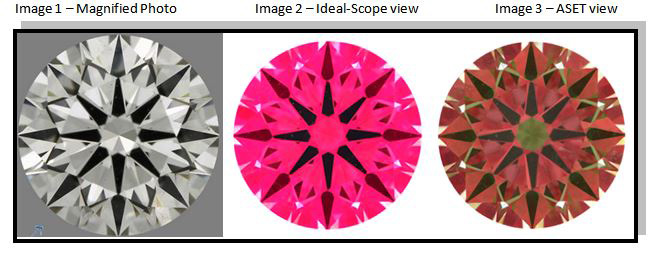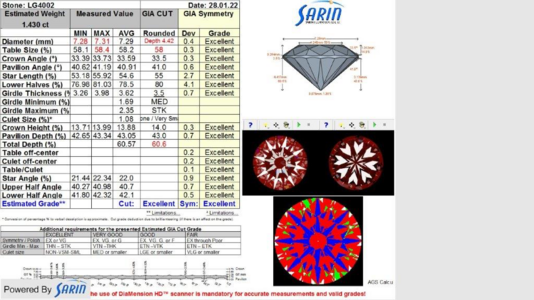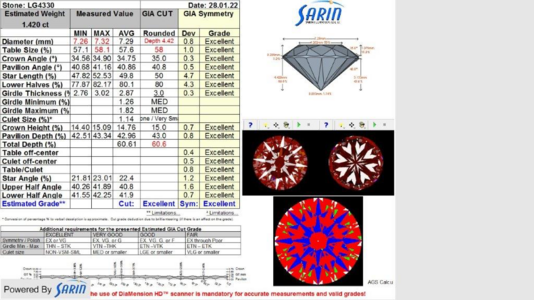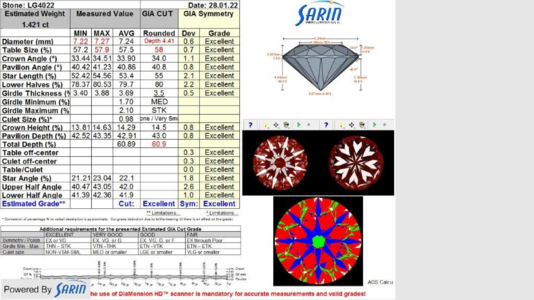You are using an out of date browser. It may not display this or other websites correctly.
You should upgrade or use an alternative browser.
You should upgrade or use an alternative browser.
Help! I don't know how to read these reports!
- Thread starter 4Sophie
- Start date
- Joined
- Aug 14, 2009
- Messages
- 27,486
I assume you're asking about the GIA and AGS interpretations on the reports?
These are two of the devices that your vendor might be using to scan the stones - based on the red text at the bottom I assume this specific vendor is using the DiaMension HD machine:
https://sarine.com/products/diamension-axiom/
https://sarine.com/products/diamension-hd/
The thing to note there is manufacturer's device accuracy specifications. For the DiaMension HD this is listed as below, and means that your uncertainty for all readings taken using this device is subject to these margins.
Linear: ± 10 microns (± 0.01 mm), Angular: ± 0.1 degrees
That means that if you submitted the exact same stone to scan with different DiaMension HD machines, you can expect to get varying readings... Sarin reports can be a bit confusing in that angular precision is often outputted to 0.01degree, and that hundredths place value is obviously meaningless if the machine doing the scanning can only be trusted to read with a one-tenth accuracy margin.
The GIA and AGS estimations are exactly that - estimations. They're not authoritative statements on how GIA or AGS would grade the stone if it was actually submitted. But as estimates go they're about as close as you're ever going to get: Sarin is authorized to use the GIA Facetware and AGS PGS calculators. The PGS software is proprietary but GIA's Facetware tool is available to the general public -
https://www.gia.edu/facetware
These are two of the devices that your vendor might be using to scan the stones - based on the red text at the bottom I assume this specific vendor is using the DiaMension HD machine:
https://sarine.com/products/diamension-axiom/
https://sarine.com/products/diamension-hd/
The thing to note there is manufacturer's device accuracy specifications. For the DiaMension HD this is listed as below, and means that your uncertainty for all readings taken using this device is subject to these margins.
Linear: ± 10 microns (± 0.01 mm), Angular: ± 0.1 degrees
That means that if you submitted the exact same stone to scan with different DiaMension HD machines, you can expect to get varying readings... Sarin reports can be a bit confusing in that angular precision is often outputted to 0.01degree, and that hundredths place value is obviously meaningless if the machine doing the scanning can only be trusted to read with a one-tenth accuracy margin.
The GIA and AGS estimations are exactly that - estimations. They're not authoritative statements on how GIA or AGS would grade the stone if it was actually submitted. But as estimates go they're about as close as you're ever going to get: Sarin is authorized to use the GIA Facetware and AGS PGS calculators. The PGS software is proprietary but GIA's Facetware tool is available to the general public -
https://www.gia.edu/facetware
DejaWiz
Ideal_Rock
- Joined
- Apr 23, 2021
- Messages
- 6,929
Diamond #2 with the 40.6/35.0/58 combo should be nicely balanced between brilliance and fire.
Diamond #1 with the 41.0/33.5/58 combo should lean towards more brilliance.
Diamond #3 with the 40.8/34.0/58 combo should also lean towards more brilliance.
I'd be most interested in Diamond #2, based on my personal preference.
Diamond #1 with the 41.0/33.5/58 combo should lean towards more brilliance.
Diamond #3 with the 40.8/34.0/58 combo should also lean towards more brilliance.
I'd be most interested in Diamond #2, based on my personal preference.
Last edited by a moderator:
Diamond #2 with the 40.6/35.0/58 combo should be nicely balanced between brilliance and fire.
Diamond #1 with the 41.0/33.5/58 combo should lean towards more brilliance.
Diamond #3 with the 40.8/34.0/58 combo should also lean towards more brilliance.
I'd be most interested in Diamond #2, based on my personal preference.
What do you think of the light return images? Are these stones worth buying based on what you see in the reports?
Last edited by a moderator:
I assume you're asking about the GIA and AGS interpretations on the reports?
These are two of the devices that your vendor might be using to scan the stones - based on the red text at the bottom I assume this specific vendor is using the DiaMension HD machine:
https://sarine.com/products/diamension-axiom/
https://sarine.com/products/diamension-hd/
The thing to note there is manufacturer's device accuracy specifications. For the DiaMension HD this is listed as below, and means that your uncertainty for all readings taken using this device is subject to these margins.
Linear: ± 10 microns (± 0.01 mm), Angular: ± 0.1 degrees
That means that if you submitted the exact same stone to scan with different DiaMension HD machines, you can expect to get varying readings... Sarin reports can be a bit confusing in that angular precision is often outputted to 0.01degree, and that hundredths place value is obviously meaningless if the machine doing the scanning can only be trusted to read with a one-tenth accuracy margin.
The GIA and AGS estimations are exactly that - estimations. They're not authoritative statements on how GIA or AGS would grade the stone if it was actually submitted. But as estimates go they're about as close as you're ever going to get: Sarin is authorized to use the GIA Facetware and AGS PGS calculators. The PGS software is proprietary but GIA's Facetware tool is available to the general public -
https://www.gia.edu/facetware
These reports were off a little from the listed IGI dimensions. I
suppose that could be due to the accuracy of the machine or the inaccuracy of the person doing the grading. I am very interested to hear your opinion of the light handling images...Thanks!
DejaWiz
Ideal_Rock
- Joined
- Apr 23, 2021
- Messages
- 6,929
What do you think of the light return images? Are these stones worth buying based on what you see in the reports?
They are the computer generated images.
Accurate to a great extent.
I would supplement them by asking for real ASET images.
What do you think of the light return images? Are these stones worth buying based on what you see in the reports?
I gave them 3 stones to read...this is not in any specific order:
1. 1.41, F,VS2, 57, 34, 40.9, 61.2, 7.21x7.25x4.43, 14.5/43.
2. 1.43, F. VVS2, 57.5, 33.7,40.9, 60.9, 7.27x7.29x4.39. 14/43.
3. 1.42 G, VS2, 57, 34.7, 40.8, 60.8, 7.26x7.7.31x4.43, 15/43.
How can these reports vary so much from the stone measurements from the lab reports? I cannot even figure out which stone goes with which report! Thanks for any help.
I gave them 3 stones to read...this is not in any specific order:
1. 1.41, F,VS2, 57, 34, 40.9, 61.2, 7.21x7.25x4.43, 14.5/43.
2. 1.43, F. VVS2, 57.5, 33.7,40.9, 60.9, 7.27x7.29x4.39. 14/43.
3. 1.42 G, VS2, 57, 34.7, 40.8, 60.8, 7.26x7.7.31x4.43, 15/43.
How can these reports vary so much from the stone measurements from the lab reports? I cannot even figure out which stone goes with which report! Thanks for any help.
I should add:
#1 HCA score 1.1 EX, EX, EX, big.
#2 HCA score 1.1 EX, EX, EX, big.
#3 HCA score 1.3 EX,EX, EX, big.
I assume you're asking about the GIA and AGS interpretations on the reports?
These are two of the devices that your vendor might be using to scan the stones - based on the red text at the bottom I assume this specific vendor is using the DiaMension HD machine:
https://sarine.com/products/diamension-axiom/
https://sarine.com/products/diamension-hd/
The thing to note there is manufacturer's device accuracy specifications. For the DiaMension HD this is listed as below, and means that your uncertainty for all readings taken using this device is subject to these margins.
Linear: ± 10 microns (± 0.01 mm), Angular: ± 0.1 degrees
That means that if you submitted the exact same stone to scan with different DiaMension HD machines, you can expect to get varying readings... Sarin reports can be a bit confusing in that angular precision is often outputted to 0.01degree, and that hundredths place value is obviously meaningless if the machine doing the scanning can only be trusted to read with a one-tenth accuracy margin.
The GIA and AGS estimations are exactly that - estimations. They're not authoritative statements on how GIA or AGS would grade the stone if it was actually submitted. But as estimates go they're about as close as you're ever going to get: Sarin is authorized to use the GIA Facetware and AGS PGS calculators. The PGS software is proprietary but GIA's Facetware tool is available to the general public -
https://www.gia.edu/facetware
Don't you have an opinion as to the light handling imagery?
DejaWiz
Ideal_Rock
- Joined
- Apr 23, 2021
- Messages
- 6,929
I gave them 3 stones to read...this is not in any specific order:
1. 1.41, F,VS2, 57, 34, 40.9, 61.2, 7.21x7.25x4.43, 14.5/43.
2. 1.43, F. VVS2, 57.5, 33.7,40.9, 60.9, 7.27x7.29x4.39. 14/43.
3. 1.42 G, VS2, 57, 34.7, 40.8, 60.8, 7.26x7.7.31x4.43, 15/43.
How can these reports vary so much from the stone measurements from the lab reports? I cannot even figure out which stone goes with which report! Thanks for any help.
Number 1 here goes with diamond #3.
Number 2 here goes with diamond #1.
Number 3 here goes with diamond #2.
The variances are due to the way the different grading labs apply gross rounding.
Don't you have an opinion as to the light handling imagery?
Number 1 here goes with diamond #3.
Number 2 here goes with diamond #1.
Number 3 here goes with diamond #2.
The variances are due to the way the different grading labs apply gross rounding.
Thank you! So, you preferred the Number 2 stone which goes with report #1? Do you have any opinion as to the light handling images? These stones are from Ritani...I am not sure they will do any more than this. Do you think any of these stones are Worth trying?
DejaWiz
Ideal_Rock
- Joined
- Apr 23, 2021
- Messages
- 6,929
Thank you! So, you preferred the Number 2 stone which goes with report #1? Do you have any opinion as to the light handling images? These stones are from Ritani...I am not sure they will do any more than this. Do you think any of these stones are Worth trying?
Sorry, I meant diamond #2 would be my preference based on the proportions and angles...the one with the 40.8/34.7/57 combo as listed on the grading report.
Since it is a G color graded by IGI, it would have to exhibit quite a lot of light return to please my eyes since I am a bit color sensitive and not very color tolerant when it comes to MRB cut.
Which dimensions would you trust? IGI or SARIN report? Based on looking at the imagery...Red is good, Green is OK, and Blue is Bad in all areas except for the arrows?Number 1 here goes with diamond #3.
Number 2 here goes with diamond #1.
Number 3 here goes with diamond #2.
The variances are due to the way the different grading labs apply gross rounding.
DejaWiz
Ideal_Rock
- Joined
- Apr 23, 2021
- Messages
- 6,929
Which dimensions would you trust? IGI or SARIN report? Based on looking at the imagery...Red is good, Green is OK, and Blue is Bad in all areas except for the arrows?
Sarin, for sure.
Here is the PS education page about ASET images:

What ASET reveals that Ideal-Scope does not
Ask 10 jewelers about one diamond and you might hear 10 different stories. Ask 10 independent appraisers and the clinical analysis may agree, but terminology and methodology can vary. But […]
www.pricescope.com
Sarin, for sure.
Here is the PS education page about ASET images:

What ASET reveals that Ideal-Scope does not
Ask 10 jewelers about one diamond and you might hear 10 different stories. Ask 10 independent appraisers and the clinical analysis may agree, but terminology and methodology can vary. But […]www.pricescope.com
So you are suggesting a REAL ASET image rather than the computer generated image from the Sarin report to accurately tell about the light handling capability of these stones?
DejaWiz
Ideal_Rock
- Joined
- Apr 23, 2021
- Messages
- 6,929
So you are suggesting a REAL ASET image rather than the computer generated image from the Sarin report to accurately tell about the light handling capability of these stones?
Yes, that is correct. Seeing is always believing, to me.
Yes, that is correct. Seeing is always believing, to me.
Then the images in the above reports mean nothing?
DejaWiz
Ideal_Rock
- Joined
- Apr 23, 2021
- Messages
- 6,929
Then the images in the above reports mean nothing?
They mean a great deal, but they are computer generated based off of data that's been entered.
You can go off of those and likely be just fine, because the generated images are quite accurate.
Me, personally, would also want to see the live ASET images because my science and engineering brain require them for utmost appeasement.
- Joined
- Aug 14, 2009
- Messages
- 27,486
Then the images in the above reports mean nothing?
They don't mean nothing but they're also not 100% accurate.
Can you get actual idealscope or ASET imagery on these? Many vendors can't, but I would presume that a vendor who can provide Sarin scans can also provide light reflector technology imagery.
From the information we've got - one is not jumping out to me as better than the other two. That's because analysis beyond a more general blunt "yup/nope" is getting into territory that nuances will affect, and nuances cannot be accurately captured in CG images from scans. All these are "yup, get more info if you can". Which I think is what @DejaWiz is saying as well.
- Joined
- Jul 31, 2014
- Messages
- 20,016
They mean a great deal, but they are computer generated based off of data that's been entered.
You can go off of those and likely be just fine, because the generated images are quite accurate.
Me, personally, would also want to see the live ASET images because my science and engineering brain require them for utmost appeasement.
Thanks for weighing in again....I will try for the actual Aset images.
I'm not sure which one I would prefer--but I agree I'd prefer an ASET if possible. I tend to prefer deeper stones than these aesthetically, but obviously everyone is different and that's just a personal preference
Thanks so much for your comments...what depth should I look for?
Thanks for weighing in again....I will try for the actual Aset images.
One more thing...if they won't provide actual Aset images...which one of the computer generated ones look the best to you?
- Joined
- Jul 31, 2014
- Messages
- 20,016
Thanks so much for your comments...what depth should I look for?
There's nothing wrong with the depth of the stones you selected. I personally prefer at least 61 depth and often gravitate towards stones closer to 62% depth. But again, this is totally personal preference and I think it's helpful to look at diamonds online from places like James Allen or blue nile (with 360 videos) so you can see what your eyes prefer (within the "safe" ranges)
I'm not sure which one I would prefer--but I agree I'd prefer an ASET if possible. I tend to prefer deeper stones than these aesthetically, but obviously everyone is different and that's just a personal preference
I'm not sure which one I would prefer--but I agree I'd prefer an ASET if possible. I tend to prefer deeper stones than these aesthetically, but obviously everyone is different and that's just a personal preference
How does this one sound.....56.5, 34.3, 40.9, 61.9.
HCA 1.4 EX,EX, VG, Big. !.41 F, VS1. 14.5/43
- Joined
- Jul 31, 2014
- Messages
- 20,016
I think it's important not to choose a stone based on numbers without any pics or videos. Numbers help weed out stones that are definitely bad, but don't help as much when choosing among stones within "Safe" ranges.
I wouldn't choose a stone solely based on numbers...the above stone has no video. I was just asking if this was better and worth looking into based on the the numbers and additional depth.
- Joined
- Jul 31, 2014
- Messages
- 20,016
Share:
Featured Topics
Past, Present, Future: The Meaning of Three-Stone Engagement Rings
Past, Present, Future: The Meaning of Three-Stone Engagement Rings - 04/14






300x240.png)